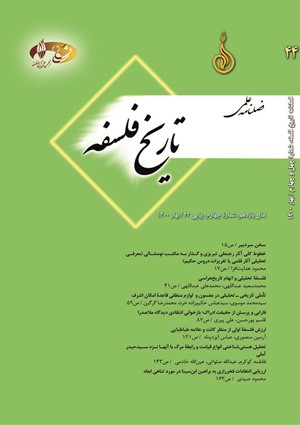خطوط کلی آثار رجبعلی تبریزی و گذار به مکتب نومشائی (معرفی تحلیلی آثار قلمی یا تقریرات دروس حکیم)
محورهای موضوعی : ریشهشناسی واژگان (اتیمولوژی) فلسفی
1 - دانشآموخته دكتری فلسفه و كلام اسلامي دانشگاه تهران، تهران، ایران
چکیده مقاله :
رجبعلي تبریزی پس از تحصیلات مقدماتی به سلوک شرعی و تهذیب نفس پرداخته، سرانجام در اصفهان به حلقة درس حکیم میرفندرسکی پیوست. اغلب تذکرهنویسان به طهارت نفسانی و تمحض تبریزی بر طبیعیات، منطق و فلسفه اذعان دارند و تنها برخی همچون صاحب ریاض العلماء، او و برخی شاگردانش را به عدم تسلط بر ادبیات عرب متهم کردهاند. حکیم تبریزی از منتقدان جدی تفکر صدرایی است. او بدین منظور، به بسط ادبیات مشائی، بازخوانی برخی قواعد آن و طرح برخی اصطلاحات نو پرداخت تا بستر تحلیل مسائل جدید در قالب «حکمت نومشائی» فراهم گردد. در عین حال، او چندان به کتابت آموزههای خویش اهتمام نمیورزید و بیشتر اوقات وی به سلوک فردی، تدریس معقول و تربیت شاگردان سپری ميشد؛ از اینرو برخی شاگردان فاضل وی، ـ بويژه پیرزاده، قوامالدین رازی و محمدسعید حکیم ـ تقریرات دروس حکیم و یادداشتهای علمی وی را تدوین کردهاند. رسالة اثبات واجب، الاصول الآصفیة، المعارف الإلهیة، مصنفات قوامالدین رازی و شرح توحید صدوقِ قاضی سعید؛ اهم منابع پژوهش در باب مکتب نومشائی حکیم تبریزی بشمار می آیند. در اینباره، گزارشهای اصحاب تراجم و برخی آراء مصححان و پژوهشگران معاصر نیز ارزیابی شدهاند.
Rajab‘alī Tabrīzī became involved in religious wayfaring and purification of the soul after his preliminary studies and, finally, joined the classes of Ḥakīm Mīr Fendereski. Most biographers acknowledge Tabrīzī’s inward purification and mastery over physics, logic, and philosophy, and only a few of them, such as the writer of Riyāḍ al-‘ulamā and some of his students, have accused him of not having mastery over Arabic literature. Ḥakīm Tabrīzī, who lived about 30 years after Mullā Ṣadrā, was one of the serious critics of Sadrian thought. In doing so, he expanded the Peripatetic literature, reinterpreted some of its principles, and introduced a number of new terminology so that a cradle could be provided for the analysis of new problems within the framework of Neo-Peripateticism. However, he did not try to record all his teachings in writing and spent most of his time on individual wayfaring, teaching intellectual sciences, and training his students. Therefore, some of his knowledgeable students, particularly Pirzādeh, Qawām al-Dīn Rāzī, and Muḥammad Sa‘īd Ḥakīm, transcribed his teachings and scientific notes. The treatise of Ithbāt al-wājib, al-Uṣūl al-aṣfīyah, al-M‘arīf al-ilāhīyyah, Muṣannafāt-i Qawām al-Din Rāzī, and Sharḥ-i Tawḥīd Ṣadūq by Qāzī S‘aīd comprise the most important research sources on Ḥakim Tabrīzī’s neo-Peripatetic school of philosophy. The reports of translators and the ideas and theories of some contemporary editors and researchers have also been evaluated in this paper.
آشتیانی، سیدجلالالدین (1363ش) منتخباتى از آثار حكماى الهى ایران، قم: دفتر تبلیغات اسلامی.
آقابزرگ تهرانی، محمدمحسن (1403ق) الذریعة إلی تصانیف الشیعة، بیروت: دار الأضواء.
افندی، عبدالله (1401ق) ریاض العلماء و حیاض الفضلاء، تحقیق احمد حسینی اشکوری، قم: كتابخانة آیت الله مرعشی.
امین، محسن (1403ق) أعیان الشیعة، تحقیق حسن امین، بیروت: دار التعارف للمطبوعات.
اوجبی، علی (1389) مقدمه بر مجموعه مصنفات میرقوامالدین رازی، تهران: حکمت.
پیرزاده، محمدرفیع زاهدی، تحفة سلیمانی، نسخة خطی 6451، کتابخانة مدرسة سپهسالار.
پیرزاده، محمدرفیع زاهدی، سؤال و جواب، نسخة خطی 1/6451، کتابخانة مدرسة سپهسالار.
پیرزاده، محمدرفیع زاهدی، المعارف الإلهیة، نسخة خطی 1919، کتابخانة مرکزی دانشگاه تهران.
حبیبی، نجفقلی (1379) مقدمه بر شرح الأربعین، تهران: میراث مکتوب.
تبریزی، رجبعلي (1386) الأصل الأصیل (ألاصول الآصفیة)، تصحیح حسن اکبری بیرق و عزیز جوان¬پور هروی، تهران: انجمن آثار و مفاخر فرهنگی.
تبریزی، رجبعلي (1385) «اثبات واجب»، مندرج در حکمت الهی در متون فارسی، گردآوری و تصحیح عبدالله نورانی، تهران: انجمن آثار و مفاخر فرهنگی و دانشگاه تهران.
تبریزی، رجبعلي، دیوان واحد تبریزی، نسخة خطی 95، کتابخانة مجلس قدیم.
ثقة الإسلام تبریزی، علی بن¬موسی (1414ق)، مرآة الکتب، تحقیق محمدعلی حائری، قم: كتابخانة آیت¬الله مرعشی.
روضاتی، سیدمحمدعلی (1386) «سعیدیه»، در دومین دو گفتار، قم: مؤسسة فرهنگی مطالعاتی الزهرا (س).
سادات ناصری، حسن (1375) مقدمه بر قصص الخاقانی، تهران: وزارت فرهنگ و ارشاد اسلامی.
شاملو، ولیقلی بیک (1375) قصص الخاقانی، تصحیح حسن سادات ناصری، تهران: وزارت فرهنگ و ارشاد اسلامی.
عسکری، مهدی (1397) تبیین و بررسی آراء ملارجبعلی تبریزی در رسالة الأصل الأصیل، پایاننامه کارشناسی ارشد، قم: دانشگاه ادیان و مذاهب.
عسکری، مهدی؛ سوری، محمد (1399) «نقد و بررسی تصحیح رساله الأصل الأصیل ملارجبعلي تبریزی»، تهران: فصلنامۀ آینه میراث، شمارة 67.
قزوینی، شیخ عبدالنبی (1404ق) تتمیم أمل الآمل، قم: کتابخانة آیت الله مرعشی.
قمی، قاضی¬سعید ابن محمد مفید (1381) الأربعینیات لکشف أنوار القدسیات، تصحیح و تعلیقات نجفقلی حبیبی، تهران: میراث مکتوب.
کربن، هانری (1387) تاریخ فلسفه اسلامی، ترجمة سیدجواد طباطبایی، تهران: کویر.
مدرس تبریزی، میرزا محمدعلی (1364) ریحانة الأدب، تهران: خیام.
مشکات، سیدمحمد (1362) مقدمه بر کلید بهشت، تهران: الزهراء (س).
مکارم، هادی (1378) «خرده¬گیران بر حکمت متعالیه و منتقدان صدرالمتألهین»، فصلنامۀ حوزه، شمارة 93.
لُنباتی، ملاحسن، تحفة الکمال، نسخة خطی 2/2470، کتابخانة مرکزی دانشگاه تهران.
نصرآبادی اصفهانی، میرزا محمدطاهر (1317) تذکرة نصرآبادی، تهران: چاپخانة ارمغان.
نوراني، عبدالله (1385) حكمت الهی در متون فارسی، تهران: انجمن آثار و مفاخر فرهنگي و دانشگاه تهران.
هدایت افزا، محمود (1399) «تحلیل مفهومی عنوان حکیم نومشائی و تطبیق آن بر رجبعلي تبریزی» فصلنامة پژوهشهای مابعدالطبیعی، شمارة 2.
هدایت افزا، محمود (1398) «توحید خالص نزد قاضی سعید قمی»، حبیب معرفت، تهران: خانة اندیشمندان علوم انسانی.
همایی، سيدجلال الدین (1381) مقدمه بر دو رساله در فلسفۀ اسلامی، تهران: مؤسسة پژوهشی حکمت و فلسفه ایران.

